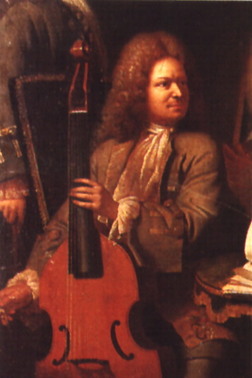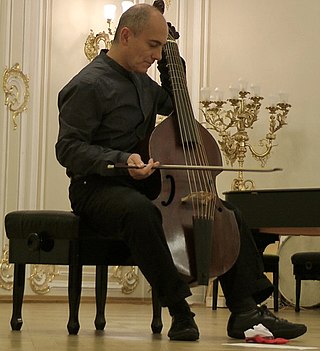
Jonathan Dunford (born 30 October 1959 in Trenton, New Jersey) is an American violist specialising in the baroque repertoire.

Jonathan Dunford (born 30 October 1959 in Trenton, New Jersey) is an American violist specialising in the baroque repertoire.
After studying the viol at the New England Conservatory of Music in Boston, Dunford was awarded a scholarship in 1980 for further training by Jordi Savall at the Schola Cantorum Basiliensis.
He obtained his mastery of viola da gamba in 1987 in Boston then his State Diploma of Ancient Music in 1989 in France.
Jonathan Dunford has been living in Paris since 1985, is married to the gambist Sylvia Abramowicz and taught at the Conservatoire de Strasbourg between 1990 and 1997 and also at the Conservatoire de Metz. He has been teaching at the Conservatory of Saint-Cloud since 2013.
He has conducted extensive research at the Bibliothèque nationale de France on music for viola da gamba.
In 2004, he was appointed workshop leader for viola da gamba for the data base "Philidor" at the Centre de musique baroque de Versailles. He has published numerous articles on the viola da gamba (Goldberg, l'Œil, record booklets) and regularly participates in radio programs (France Musique, Radio Bleu, etc.) and television programs (Mezzo).
In 2016 he founded his own digital label "Astres Disques". [1]
Jonathan Dunford plays on a bass viola da gamba built in 1741 by Parisian luthier Solomon.
His son Thomas Dunford, [2] born in Paris in 1988, plays the lute and theorbo and participates in recordings and in early music festivals. [3] [4] [5]

The viol, viola da gamba, or informally gamba, is any one of a family of bowed, fretted, and stringed instruments with hollow wooden bodies and pegboxes where the tension on the strings can be increased or decreased to adjust the pitch of each of the strings. Frets on the viol are usually made of gut, tied on the fingerboard around the instrument's neck, to enable the performer to stop the strings more cleanly. Frets improve consistency of intonation and lend the stopped notes a tone that better matches the open strings. Viols first appeared in Spain in the mid-to-late 15th century, and were most popular in the Renaissance and Baroque (1600–1750) periods. Early ancestors include the Arabic rebab and the medieval European vielle, but later, more direct possible ancestors include the Venetian viole and the 15th- and 16th-century Spanish vihuela, a six-course plucked instrument tuned like a lute that looked like but was quite distinct from the four-course guitar.

Marin Marais was a French composer and viol player. He studied composition with Jean-Baptiste Lully, often conducting his operas, and with master of the bass viol Monsieur de Sainte-Colombe for six months. In 1676 he was hired as a musician to the royal court of Versailles and was moderately successful there, being appointed in 1679 as ordinaire de la chambre du roy pour la viole, a title he kept until 1725.

Jordi Savall i Bernadet is a Spanish conductor, composer and viol player. He has been one of the major figures in the field of Western early music since the 1970s, largely responsible for popularizing the viol family of instruments in contemporary performance and recording. As a historian of early music his repertoire features everything from medieval, Renaissance and Baroque through to the Classical and Romantic periods. He has incorporated non-western musical traditions in his work; including African vernacular music for a documentary on slavery.
Jean (?) de Sainte-Colombe (c. 1640 – c. 1700) was a French composer and violist. Sainte-Colombe was a celebrated master of the viola da gamba. He is credited (by Jean Rousseau in his Traité de la viole (1687)) with adding the seventh string, tuned to the note AA (A1 in scientific pitch notation), on the bass viol.

Antoine Forqueray was a French composer and virtuoso of the viola da gamba.
Machy, known as Le Sieur de Machy was a French viol player, composer, and teacher remembered principally for his Pièces de Violle en Musique et en Tablature (1685), a valuable source of information on the performance practices of his time. "The publication of the Pièces de Violle (..) unleashed a veritable polemic or querelle with Jean Rousseau concerning the “true manner of playing the viol”, which had been described by De Machy with a wealth of details in the prologue to his work (..)".. As an reply to de Machys 1685 prologue, Rousseau in 1688 published Réponce de Monsieur Rousseau. This polemic and a general discussion of de Machy was treated by Ng 2008.

Paolo Pandolfo is an Italian virtuoso player, composer, and teacher of music for the viola da gamba, born on January 31, 1964.

Vittorio Ghielmi is an Italian musician, conductor, compose Compared by critics to Jasha Heifetz ("Diapason") for his virtuosity, and described as "An Alchemist of sound" for the intensity and versatility of his musical interpretations, Vittorio Ghielmi attracted notice while still very young for his new approach to the viola da gamba and to the sound of early music repertoire. He is Professor for viola da gamba and Head of the Department für Alte Musik at the Mozarteum Universität Salzburg and visiting professor at the Royal College of London. He is graduate at the Università Cattolica di Milano.
Sophie Watillon was a Belgian viol player who specialized in Baroque music. She was born in Namur, Belgium to a musical family. During her young life, the viola da gamba-soloist gained international fame with refined and sensitive solo interpretations of Early Music and Baroque compositions for viola da gamba.
The Ensemble À Deux Violes Esgales, stylized on their website as A 2 Violes Esgales, was formed in 1984 by the gambists Sylvia Abramowicz and Jonathan Dunford. The group has recorded a dozen albums mostly for Accord, Universal Music France. Based in Paris they tour the world with varied programs from recitals to a larger group with singers.
Hubert Le Blanc was a French viol player, doctor of law and abbé. Strongly regretting that viol playing was falling out of fashion, he wrote the treatise Défense de la basse de viole contre les enterprises du violon et les prétentions du violoncelle, which was published in Amsterdam by Pierre Mortier in 1740.
Charles Medlam is an English conductor and cellist also known for his performances on viola da gamba.

Tous les matins du monde is a 1991 French film based on the book of the same name by Pascal Quignard. Set during the reign of Louis XIV, the film shows the musician, Marin Marais, looking back on his young life when he was briefly a pupil of Monsieur de Sainte-Colombe, and features much music of the period, especially that for the viola da gamba. The title of the film is explained towards the end of the film; « Tous les matins du monde sont sans retour » spoken by Marais in chapter XXVI of Quignard's novel when he learns of the death of Madeleine.
Le Sieur Danoville was a French gambist and instrumental teacher.
Rolf Lislevand, is a Norwegian performer of Early music specialising on lute, vihuela, baroque guitar and theorbo.
Pièces de viole were collections of suites for bass viol and usually continuo written by several French Baroque composers, most notably Marin Marais, whose five Livres form a core of the viol repertoire. Early pièces did not include continuo parts; examples of these may be found in the oeuvres of Sieur de Sainte-Colombe and Nicolas Hotman. Derived from lute and theorbo music, they often featured preludes sans mesures, and virtuosic bowed trills, whilst remaining French in their dance rhythms and melodies. Formally they also mirrored the pièces de clavecin being written by virtuoso harpsichordists. Marais and his contemporaries further established a uniquely French tradition of virtuosic pieces for viol and continuo. The pièces were typically written in dance forms like the Allemande, Gavotte, Sarabande, and Gigue, augmented by a Prélude or a Fantaisie and with additional character pieces like Plaintes and Tombeaux.
Nicolas Métru was a French organist, viol player, and composer of pieces for viol and airs. From 1642 he was organist at St. Nicolas-des-Champs, then some time later master of music for the Jesuits. He taught Couperin and Lully and was an outstanding viol player.
Fuoco E Cenere is an early music ensemble based in Paris and directed by Jay Bernfeld.
Jean (Baptiste) Cappus was a French composer. The second name ‘Baptiste’ is attested only on his 1730 book of viol music.
Jérôme Hantaï is a viola da gamba player and fortepianist.